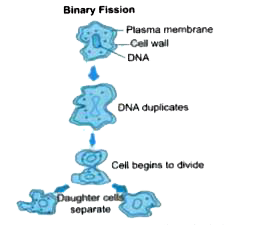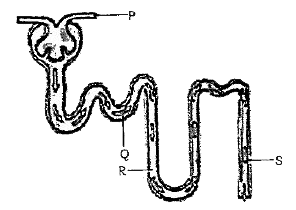(i) Describe the various steps involved in the process of binary fission with the help of a diagram.
(ii) Why do multicellular organisms use complex way of reproduction ?
(i) 
(ii) Multicellular organisms are made of collection of cells, which have differentiated to form various tissues. Hence, there are different types of specialised cells. Rather than each different cell undergoing cell division for reproduction, these organisms have special structures / cells to undergo or help in reproduction. This ensures continuity of species.
Topper's Solved these Questions
- SAMPLE QUESTION PAPER 2019 - 20 (SOLVED)BOOK - U-LIKE SERIESCHAPTER - SAMPLE QUESTION PAPER 2019 - 20 (SOLVED)EXERCISE - SECTION B
18 Videos
- MAGNETIC EFFECTS OF ELECTRIC CURRENT BOOK - U-LIKE SERIESCHAPTER - MAGNETIC EFFECTS OF ELECTRIC CURRENT EXERCISE - LONG ANSWER QUESTIONS
18 Videos
- THE HUMAN EYE AND THE COLOURFUL WORLD BOOK - U-LIKE SERIESCHAPTER - THE HUMAN EYE AND THE COLOURFUL WORLD EXERCISE - LONG ANSWER QUESTIONS
8 Videos
Similar Questions
Knowledge Check
Case 2 : the biological process involved in the removal of harmful metabolic wastes from the bosy is called excertion .Different organisms use varied strategies to do this Many unicellular organisms remove these wastes by simple diffusion from the body surface into the surrounding water while complex multicellular organisms use specialised organs to perform the same function .
the excretory system of humna beings include :Aa pair of kidney , a pair of urinary bladders , a urinary bladders , a ureter , and a urethra.Ba kidney , a ureter , a urinary bladder and a urethra .Ca pair of kidney , a pair of ureters , a pair of urinary bladders and a urethra .Da pair of kidney , a pair of ureters , a urinary bladder and a urethra .The biological process involved in the removal of harmful metabolic wastes from the body is called excretion. Different organisms use varied strategies to do this. Many unicellular organisms remove these wastes by simple diffusion from the body surface into the surrounding water while complex multicellular organisms use specialised organs to perform the same function.
Each kidney is made up of a large number of excretory units calledAGlomerulusBNephronsCBowman's CapsuleDBlood capillaries
What is somatic hybridisation? Explain the various steps involved in the process. Mention any two uses of somatic hybridisation
View SolutionWith the help of a labelled diagram show
(a) Nitrogen cycle in nature
(b) Describe briefly any two processes involved in the cycling of N2 in the environment.
OR
With the help of a labelled diagram show the cycling of carbon in nature. What are the two ways in which carbon dioxide is fixed in the environment.
View SolutionWhat is glycolysis ? Describe various steps involved in glycolysis using schematic representation.
View SolutionWhat is 'glycolysis ? Describe various steps involved in glycolysis using schematic representation.
View SolutionDescribe the working of human blood circulatory system with the help of a suitable diagram which shows all the steps involved.
View SolutionCase 2 : the biological process involved in the removal of harmful metabolic wastes from the bosy is called excertion .Different organisms use varied strategies to do this Many unicellular organisms remove these wastes by simple diffusion from the body surface into the surrounding water while complex multicellular organisms use specialised organs to perform the same function .
The given figure represent the structure of nephron.

Whihc of the following is responsible for concentrating the solute in the filtrate ?
View Solution
